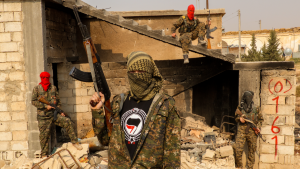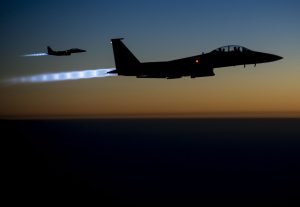It all started with the graffiti. Teenage boys sprayed “The people want the fall of the government,” onto a wall in Dara’a, an ancient city on Syria’s southern border. A month later, 1,000 civilians had been killed by government forces, and people were taking up arms against the brutal regime of longtime dictator Bashar al-Assad.
Today, Dara’a lies in shambles. 400,000 people have died in the world’s bloodiest ongoing civil war, and over 11 million have been displaced within and outside of Syria. Four rounds of peace talks held by the United Nations in Geneva have gone by without any notable progress. “The international community has failed,” Daniel Neep, assistant professor at the Center for Contemporary Arab Studies in Georgetown, told the HPR.
The Syrian Civil War has become an increasingly complex conflict, fracturing the country along sectarian lines and drawing in a variety of outside actors. While major international players continue to pay lip service to the goal of conflict resolution, few have advanced concrete solutions for restoring long-term peace. A policy of federalization, with Assad remaining in control, and the establishment of a power-sharing coalition government remain on the table. The most likely outcome, however, is a solution almost all actors still publicly oppose: the partition of Syria.
A Nation Divided
As violence escalated in the spring of 2011, political allegiances increasingly fractured along confessional lines. Although over two thirds of Syrians are Sunni Muslims, the Alawite minority of Bashar al-Assad has dominated Syria politically and economically for decades. Strong minority support for the government led Assad to rely on sectarian militias, including the notorious Alawite “Shabiha” paramilitary, armed Christian groups, the Lebanon-based Hezbollah, and even Shia volunteers from Afghanistan and Pakistan.
Likewise, the mostly-Sunni rebel groups began to claim religious rather than secular values to mobilize the anti-Assad opposition, with groups like the al-Nusra Front even pledging loyalty to al-Qaeda. The rise of ISIS brought further instability, triggering a Russian intervention on behalf of the government.
Only Kurdish forces in the country’s north, funded by U.S. aid, have managed to retain and even strengthen their position, establishing a decentralized coalition modeled loosely on the Swiss cantons. Their military arm, the multi-ethnic but majority-Kurdish “Syrian Democratic Forces,” plays a highly influential role in the fight against ISIS in Raqqa and elsewhere.
Proxy War
“Peace in Syria depends in a tremendous amount on the international actors,” Director of the Syria Institute Valerie Szybala told the HPR. Effectively, the Syrian Civil War has been transformed into a regional and international proxy war, involving numerous outside players.
Syria has become the most important theater in the regional “cold war” between Shia Iran and the Sunni Gulf States, led by Saudi Arabia. The Sunni states have funneled vast amounts of money into the Islamist opposition. Iran, on the other hand, has supported its Syrian ally in order to maintain the corridor of friendly Shia states connecting Iran to Lebanon’s Shia Hezbollah militia. The Ayatollahs have also sent Iran’s elite Revolutionary Guard to reinforce their allies on the ground. In Szybala’s words, “Iran has brought in a significant number of militiamen to settle.”

Western antifascist fighters in Rojava, August 2017.
The conflict has also drawn in powers from outside the region. In September 2015, Russia, a loyal backer of the Assad regime, began attacking not only ISIS, but also rebel positions. While Russia has economic and geopolitical interests in Syria, as well as an important military base on the Syrian coast, its involvement in the conflict has also served an important role in domestic propaganda.
U.S. policy in Syria has prioritized a few general objectives—counteracting Iranian influence, battling terrorist groups, and empowering moderate pro-democracy forces, for instance— but a lack of strategic clarity has muddled the coherence of its response. Obama famously disregarded the red line he had drawn about the use of chemical weapons; Trump has frequently changed his stance on the Assad regime.
Lastly, growing Kurdish autonomy has prompted Turkey’s strongman Recep Tayyip Erdogan, a vocal critic of the Assad regime, to send Turkish troops into Syria. Erdogan fears that Kurdish self-government in Syria’s Rojava province could rouse Kurdish separatist forces in the adjacent provinces of eastern Turkey.
The increasing investment of foreign parties has created a spiral of violence, in which no actor appears willing to compromise for fear of being perceived as weak. As positions harden, it is becoming all but impossible to find a solution acceptable to all sides.
Avenues for Peace
In some regards, the most straightforward option is a brokered peace between the regime and the opposition. This would likely result in a decentralization of power in Syria, through the creation of new federal government structures. Remarkably, the United States, Russia, and even Bashar al-Assad himself have at various points voiced support for a policy of federalization. Kurdish leaders have promoted their federation as a model for post-war Syria. Federalization, advocates argue, allows local religious and ethnic groups to retain their autonomy, while maintaining a central government that upholds law and order.
However, a decentralized Syrian state, as envisioned by Putin and his allies, would still be headed by Bashar al-Assad. Nikki Haley, United States ambassador to the United Nations, has been clear in her disapproval of the Syrian tyrant: “It’s going to be hard to see a government that’s peaceful and stable with Assad.” Nor would the Syrian opposition, which has hinged its peace negotiations on Assad’s removal from office, likely agree to this deal. “There is a war criminal still in office,” Szybala underscored, a dilemma that brokered federalization would do nothing to address.
Alternatively, if Assad could be forced to relinquish power, Russia and Syria’s minorities might be willing to institute a coalition government and divide power between the various ethnic and religious groups. A power-sharing regime would enshrine the principles of joint exercise of power, proportionate distribution of parliamentary seats, and local autonomy in a newly drafted constitution.
If Syrians are looking for a model of “consociational democracy,” they might turn to neighboring Lebanon. Though power sharing in the country has encouraged corruption, clientelism, and inefficiencies, it has also allowed Lebanon to remain relatively stable over the past three decades.
Still, for all of their similarities, Lebanon and Syria differ greatly in their ethnic makeup. While the three major religious groups in Lebanon comprise a roughly equal share of the population, almost 70 percent of Syrians are Sunni Muslims. For the Alawite elite to freely give up their power, minorities would likely need to be enticed by special privileges under the new system. If not, proportionate representation in Syria could lead to the marginalization of ethnic minorities.
Furthermore, Assad’s removal from power is becoming increasingly unlikely. Complete regime change would most likely require large-scale U.S. intervention and a prolonged period of nation building, both of which are highly unlikely given isolationist public opinion in the United States and fervent Russian opposition abroad. Neep explained that as Western calls for Assad to step down have slowed to a trickle, the regime has consolidated power in areas under its control, empowered by consistent Russian support.
Divided for Good
Realistically, neither the government nor the opposition is likely to regain control of Syria in its pre-2012 borders. Bashar al-Assad is almost certain to maintain his grip over the coastal strip between Damascus, Aleppo, and the Mediterranean. At the same time, the majority-Kurdish “Syrian Democratic Forces” in the north have proven remarkably resilient in the face of incursions from ISIS, Turkey, and Assad’s army.

A pair of USAF F-15E Strike Eagles return to Iraq after conducting airstrikes in Syria, September 2014.
No major faction has yet dared address the elephant in the room—the very realistic prospect of partition. Almost all foreign powers remain publicly opposed to dividing the country along ethnic and religious lines. Partition recalls darker periods of the Middle East’s history, when borders were created with the stroke of a pen and conflicts solved by the forced resettlement of minority ethnic groups.
Yet if military forces reach a stalemate and internationally negotiated peace deals continue to fail, the various actors might reach a tacit agreement on dividing the country into respective spheres of influence. Partition is the solution that no one wants, but the one most everyone might be willing to accept. “The first block to go would be the Kurdish canton in the north,” predicted Szybala. In one likely scenario, Assad would retain control over the west and parts of the south, the Syrian Democratic Forces would keep the north, and the east and parts of the south would be split between a mix of government and opposition forces. This formulation also suits many of the international players involved: Russia keeps its military bases in Syria, Iran preserves its Shia-controlled corridor to Hezbollah, and both the Sunni states and the United States increase their influence in the country.
The graffiti written onto the walls of Dara’a cannot be erased again. The trust eroded by an oppressive police state, sectarian violence, terrorist insurgency, and mass executions will be hard to regain. Currently, the conflict shows few signs of stopping: “In the immediate future, I don’t think there is any chance for peace,” Szybala told the HPR. Real peace seems as unlikely as a reversal to the status quo ante before the Arab Spring. The Syrian Civil War, launched with the intention of transforming Syria, may in the end only prove capable of shattering the country.
Image credit: Flikr/watchsmart // archive.org/International Freedom Battalion // Wikimedia/Senior Airman Matthew Bruch
